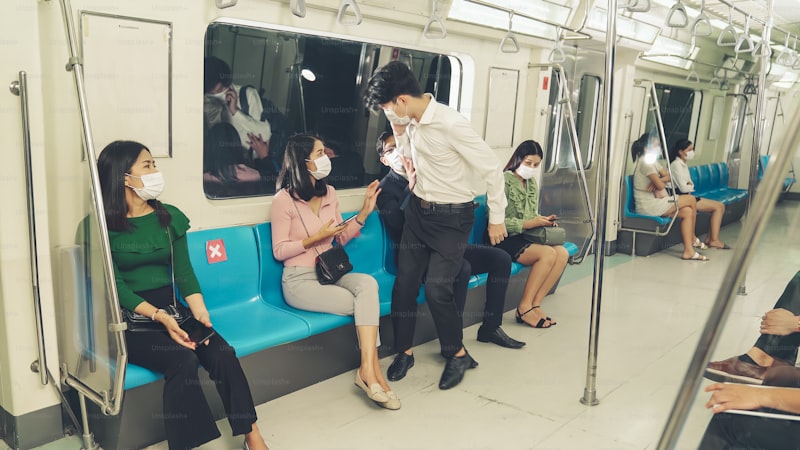One of the most striking improvements is the integration of real-time data and GPS technology. Gone are the days of waiting uncertainly at bus stops or train platforms. Now, commuters can track the exact location and arrival times of vehicles through mobile apps or digital displays at stops. This not only reduces waiting times but also enhances overall convenience and reliability, making public transport a more attractive option for daily commuters.
Moreover, the concept of smart infrastructure is taking center stage. Cities are increasingly investing in intelligent traffic management systems that prioritize buses and provide green corridors, minimizing congestion and optimizing travel times. This not only speeds up journeys but also contributes to reducing carbon footprints, aligning public transport with sustainability goals.

Safety and security have also seen significant upgrades with the advent of technology. Surveillance cameras, emergency alert systems, and automated passenger counting not only ensure a safer journey but also provide valuable data for improving service efficiency. This interconnected network of technologies fosters a sense of security among commuters, encouraging more people to choose public transport over private vehicles.
Furthermore, the rise of electric and hybrid vehicles marks a pivotal shift towards greener transportation options. These vehicles not only reduce emissions but also operate more quietly, contributing to a quieter and cleaner urban environment. Cities worldwide are increasingly adopting electric buses and trains, leading the charge towards a more sustainable future.
From Smart Cards to Seamless Travel: Innovations Revolutionizing Public Transit
Gone are the days of fumbling for change or standing in long queues to buy paper tickets. Smart cards, such as London’s Oyster card or Hong Kong’s Octopus card, have become ubiquitous symbols of seamless travel. These cards use RFID (Radio Frequency Identification) technology to store travel credits, allowing commuters to pay fares with a simple tap on a card reader. It’s like having a magic wand that grants you access to buses, trains, and even ferries effortlessly.
But the evolution doesn’t stop there. Mobile ticketing apps have taken convenience to the next level. With just a few taps on your smartphone, you can purchase tickets, plan routes, and even receive real-time updates on delays or changes in service. It’s like having a personal assistant for your daily commute, keeping you informed and on schedule.
These innovations are not just about convenience; they’re also making public transit more accessible and inclusive. By digitizing fare payment systems, cities are reducing barriers for people with disabilities and elderly citizens who may struggle with traditional ticketing methods. It’s about creating a transport system that works for everyone, regardless of their circumstances.
Moreover, these technologies are helping cities gather valuable data that can improve service efficiency. By analyzing travel patterns and peak times, transit authorities can optimize routes, allocate resources more effectively, and ultimately reduce congestion and environmental impact. It’s a win-win situation for both commuters and the planet.
As we look to the future, the possibilities for innovation in public transit seem limitless. Imagine a world where your transit pass seamlessly integrates with other services like bike-sharing or parking, all managed from a single app on your phone. The future of urban mobility is smart, connected, and designed to make our lives easier.
5G and Beyond: How Connectivity is Redefining Urban Mobility
One of the most exciting aspects of 5G’s impact on urban mobility lies in its ability to power autonomous vehicles. These vehicles, equipped with advanced sensors and real-time data processing capabilities, can navigate city streets with a level of precision and safety previously unimaginable. Picture a fleet of self-driving cars communicating seamlessly with traffic lights, pedestrian signals, and each other, creating a choreographed dance of movement that minimizes congestion and maximizes efficiency.
But it’s not just about cars. 5G is also set to enhance public transportation systems, making buses and trains smarter and more responsive to the needs of commuters. Real-time data analytics will optimize routes based on demand patterns, ensuring that public transport becomes a more attractive and viable option for city dwellers. This means fewer cars on the road, reduced emissions, and a cleaner, greener urban environment.
Beyond transportation, 5G will usher in a new era of interconnected urban infrastructure. From smart streetlights that adjust their brightness based on pedestrian activity to connected parking meters that guide you to an available spot, every aspect of city life will be touched by the power of real-time data and seamless connectivity.
Imagine walking down a street where your smartphone guides you to the nearest bike-sharing station, alerts you to upcoming events based on your interests, and even directs you to the least crowded coffee shop for your morning latte. This level of personalized urban experience is not just futuristic dreaming – it’s becoming a reality thanks to the rapid advancements in 5G technology.
The Rise of On-Demand Services: Apps Reshaping Commuter Experiences
On-demand services have revolutionized commuting in ways we couldn’t have imagined a decade ago. Take ride-sharing apps, for instance. Instead of waiting on a street corner trying to hail a taxi, commuters now use apps like Uber and Lyft to summon a ride within minutes. This convenience not only saves time but also provides a level of safety and reliability that traditional taxi services struggled to match.
Food delivery apps have also transformed how we eat. Hungry commuters can browse through a plethora of restaurants, place an order, and have their favorite meals delivered right to their doorsteps. Services like DoorDash and Uber Eats have made dining out as easy as staying in, catering to busy professionals and families alike.
Moreover, on-demand apps extend beyond transport and food. Fitness enthusiasts can book a yoga session at home or hire a personal trainer for a workout session via apps like ClassPass or Trainiac. This flexibility means that hectic schedules no longer stand in the way of staying fit and healthy.
The beauty of these apps lies in their ability to adapt to our needs and lifestyles seamlessly. They’re designed to be user-friendly, offering intuitive interfaces that make booking a service a breeze. Want to know where your ride or delivery is? Just check the app for real-time updates.
As on-demand services continue to evolve, they’re reshaping not only how we commute but also our expectations of convenience and efficiency. The days of waiting in line or being tied to fixed schedules are becoming a thing of the past, replaced by a world where everything we need is just a tap away.
AI in Motion: How Artificial Intelligence is Optimizing Transit Operations

Imagine this: AI algorithms analyzing traffic patterns in real-time, directing buses and trains to the least congested routes, saving commuters precious minutes each day. This isn’t some distant dream; it’s happening right now. Cities around the globe are harnessing AI’s predictive power to anticipate traffic flows, adjust schedules dynamically, and minimize delays.
But AI’s impact goes beyond optimizing routes. It’s enhancing safety too. Machine learning algorithms are adept at detecting anomalies—like a stalled vehicle on a busy highway or a pedestrian stepping onto the road unexpectedly—alerting transit operators instantly so they can take proactive measures to prevent accidents.
In the realm of customer service, AI-driven chatbots are providing real-time updates to passengers about delays, schedule changes, or even the availability of seats, all through a simple text message or app notification. This level of personalized communication not only improves customer satisfaction but also builds trust in public transportation systems.
Furthermore, AI’s role in maintenance cannot be overstated. Predictive analytics powered by AI can foresee mechanical issues before they occur, allowing maintenance crews to perform proactive repairs and prevent breakdowns. This proactive approach not only saves money but also ensures that vehicles are consistently available to serve passengers.
Eco-Friendly Commutes: Electric Vehicles Paving the Way Forward
Imagine cruising down the street in a vehicle that hums quietly, leaving behind nothing but the faint whisper of its tires on the pavement. That’s the promise of electric vehicles. Unlike traditional gas guzzlers, EVs run on rechargeable batteries and produce zero tailpipe emissions. This means cleaner air for everyone, as they don’t release harmful pollutants like carbon monoxide or nitrogen oxides.
But it’s not just about what comes out of the tailpipe; it’s also about what goes into making these vehicles move. EVs are inherently more efficient than their combustion engine counterparts. They convert a higher percentage of the electrical energy from the grid to power the wheels, whereas internal combustion engines waste a significant portion of their energy as heat.
Moreover, the technology behind EVs is advancing rapidly. Battery ranges are extending, alleviating the range anxiety that once plagued potential buyers. Charging infrastructure is also expanding, with more public charging stations popping up in cities and along highways. It’s becoming easier than ever to keep your EV charged and ready to go.
From sleek sedans to rugged SUVs and even heavy-duty trucks, electric vehicles are now available in various shapes and sizes to suit different lifestyles and needs. Whether you’re commuting to work, running errands around town, or embarking on a road trip, there’s likely an EV that fits your requirements.
In addition to their environmental benefits, electric vehicles are also cheaper to operate and maintain over time. With fewer moving parts than traditional vehicles, EVs generally require less servicing and have lower maintenance costs.
As more automakers invest in electric vehicle technology and governments incentivize their adoption, the future of transportation looks increasingly electrifying. The shift towards eco-friendly commutes isn’t just a passing fad—it’s a movement towards a cleaner, quieter, and more sustainable tomorrow. So, the next time you hear the whisper of an electric motor passing by, consider the impact it’s making on our world.
Real-Time Data Revolution: Tracking and Predicting Transit Trends
Imagine this: you’re standing at a bustling city intersection, wondering when your bus will arrive. Instead of relying on a fixed schedule that may or may not reflect current conditions, real-time data provides up-to-the-minute information on bus locations, delays, and estimated arrival times. It’s like having a crystal ball for transit—predicting not just when your ride will come, but how long it will take to get to your destination.
This revolution isn’t just about convenience—it’s about efficiency and sustainability. By analyzing real-time data, transit authorities can optimize routes, allocate resources more effectively, and reduce congestion. Think of it as a traffic controller directing vehicles through the busiest intersections of a city, ensuring smooth flow and minimal delays.
For commuters, this means fewer surprises and less time spent waiting. Real-time data apps and platforms allow users to plan their journeys with confidence, adjusting on the fly to changing conditions. No more rushing to the bus stop only to find it departed early or waiting endlessly for a delayed train. With real-time insights at your fingertips, you’re in control of your commute like never before.
But the benefits go beyond individual convenience. Cities can use aggregated data to spot trends, plan future infrastructure investments, and even predict demand patterns based on historical data. It’s a bit like weather forecasting for transit—anticipating peaks and valleys in commuter traffic, and adjusting services accordingly.
Frequently Asked Questions
How is technology improving safety in public transportation
Discover how technology enhances safety in public transportation through innovations like real-time monitoring, GPS tracking, emergency communication systems, and predictive maintenance. These advancements help ensure smoother operations, quicker responses to incidents, and improved passenger security.
What role does data analytics play in improving public transportation services
Learn how data analytics enhances public transportation by optimizing routes, predicting demand, and improving efficiency, leading to better service reliability and customer satisfaction.
In what ways is technology reducing environmental impact in transit
Discover how technology is reducing environmental impact in transit through innovations like electric vehicles, efficient route planning algorithms, and real-time monitoring systems.
How does smart payment technology benefit public transit users
Learn how smart payment technology improves public transit with faster transactions, seamless travel experiences, reduced queue times, and convenient payment options through cards or mobile devices.
What are the benefits of real-time tracking and scheduling systems
Learn about the advantages of real-time tracking and scheduling systems, which optimize efficiency by providing up-to-the-minute location and status updates of resources. Enhance productivity, reduce delays, and improve customer satisfaction through better resource management and proactive decision-making.


